Bardu |
|||||||||||||||||||
 |
 |
||||||||||||||||||
Knitted jumper with round yoke in DROPS Air. The piece is worked top down with Nordic pattern. Sizes S - XXXL.
DROPS 196-9 |
|||||||||||||||||||
|
EXPLANATIONS FOR THE PATTERN: ------------------------------------------------------- PATTERN: See diagrams A.1 to A.3. Find your size in the diagrams. The whole pattern is worked in stocking stitch. KNITTING TIP-1: To avoid the knitting tension becoming tighter when working pattern it is important that the strands at the back of the piece are not tight. You can use a larger needle size when working pattern if this is a problem. KNITTING TIP-2: It is important that the knitting tension is maintained also in height, or the yoke will be too short and the armholes too small! Check the tension as you go and if it is right in width but not in length, you can work extra rows with forest green after the 2nd and/or the 3rd rows with increases (row with arrow) to get the right length for your size. INCREASE TIP-1 (evenly spaced): To work out how to increase evenly, count the total number of stitches on the needle (e.g. 84 stitches) and divide by the number of increases to be made (e.g. 20) = 4.2. In this example, increase by making 1 yarn over after approx. each 4th stitch. On the next round knit the yarn overs twisted to avoid holes. INCREASE TIP-2 (for sides of body): Work until there are 2 stitches left before the marker thread, 1 yarn over, knit 4 (marker thread sits in the middle of these 4 stitches), 1 yarn over (= 2 stitches increased). On the next round knit the yarn overs twisted to avoid holes. DECREASE TIP-1 (evenly spaced): To work out how to decrease evenly, count the total number of stitches on the needle (e.g. 54 stitches) and divide by the number of decreases to be made (e.g. 2) = 27. In this example, decrease by knitting each 26th and 27th stitch together. DECREASE TIP-2 (for sleeves): Decrease 1 stitch on each side of the marker thread as follows: Work until there are 3 stitches left before the marker thread, knit 2 together, knit 2 (marker thread sits in the middle of these 2 stitches), slip 1 stitch as if to knit, knit 1 and pass the slipped stitch over the knitted stitch (= 2 stitches decreased). ------------------------------------------------------- START THE PIECE HERE: ------------------------------------------------------- JUMPER - SHORT OVERVIEW OF THE PIECE: The piece is worked in the round with circular needle, from mid back and top down. The sleeves are worked in the round with double pointed needles/short circular needle, top down. JUMPER: NECK: Cast on 84-88-92-100-104-108 stitches with short circular needle size 4.5 mm and forest green. Knit 1 round. Now work rib (knit 2, purl 2) until the rib measures 4 cm. YOKE: Change to short circular needle size 5.5 mm. Now knit 1 round where you increase 20-20-24-24-28-28 stitches evenly on round – read INCREASE TIP-1 = 104-108-116-124-132-136 stitches. Knit 1 round. Now work pattern A.1 (find your size in the diagram) in the round and increase stitches evenly on the rounds marked with an arrow in the diagram. REMEMBER THE KNITTING TENSION! Read KNITTING TIP-1 and KNITTING TIP-2! ARROW-1: Increase 24-28-32-32-32-32 stitches evenly on round = 128-136-148-156-164-168 stitches. ARROW-2: Increase 32-32-36-36-36-40 stitches evenly on round = 160-168-184-192-200-208 stitches. ARROW-3: Increase 32-36-38-36-40-44 stitches evenly on round = 192-204-222-228-240-252 stitches. ARROW-4: Increase 24-30-30-30-30-36 stitches evenly on round = 216-234-252-258-270-288 stitches. ARROW-5: Increase 6-12-24-30-30-36 stitches evenly on round = 222-246-276-288-300-324 stitches. When the increases on the round marked with arrow-5 are finished, continue as follows in the different sizes: Sizes S, M, L and XL: Continue until there is 1 round left in the diagrams. The piece should now measure 25-27-27-30 cm from the cast-on edge down. Sizes XXL and XXXL: Continue with pattern as before and increase as follows: ARROW-6: Increase 28-28 stitches evenly on round = 328-352 stitches. When the increases on the round marked with arrow-6 are finished, continue until there is 1 round left in the diagrams. The piece should now measure 33-34 cm from the cast-on edge down. ALL SIZES: Work the last round in the diagrams as follows: Work the first 31-34-39-42-48-52 stitches (= half back piece), place the next 48-54-60-60-68-72 stitches on a thread for sleeve, cast on 6-6-6-8-8-8 new stitches on the needle (= in side under sleeve), work the next 63-69-78-84-96-104 stitches (= front piece), place the next 48-54-60-60-68-72 stitches on a thread for sleeve, cast on 6-6-6-8-8-8 new stitches on the needle (= in side under sleeve), work the remaining 32-35-39-42-48-52 stitches (= half back piece). THE PIECE IS NOW MEASURED FROM HERE! BODY: = 138-150-168-184-208-224 stitches. Now work pattern as follows: Work A.2 (find your size in diagram) in the round. The pattern on the body should match the pattern on the yoke so that each repeat of A.2 is over each repeat of A.1! In sizes S and M increase 6-2 stitches evenly on the row marked with a black dot in A.2 (do not increase in sizes L, XL, XXL and XXXL) = 144-152-168-184-208-224 stitches. When A.2 has been completed in height continue with moss green and stocking stitch. Now insert 1 marker thread in each side as follows: Insert the first marker thread after the first 36-38-42-46-52-56 stitches, then the second marker thread after the next 72-76-84-92-104-112 stitches. There are 36-38-42-46-52-56 stitches left on the round after the second marker thread. On the next round increase 2 stitches in each side (= 4 stitches increased on the row) - read INCREASE TIP-2. Increase like this every 4-2-3-4-5-6 cm a total of 2-4-4-4-3-3 times = 152-168-184-200-220-236 stitches. When the piece measures 24-24-26-25-24-25 cm increase 24-28-28-32-36-36 stitches evenly on round = 176-196-212-232-256-272 stitches. Change to circular needle size 4.5 mm. Work rib (knit 2, purl 2). When the rib measures 6 cm cast off with knit over knit and purl over purl; but to avoid the cast off edge being tight you can make 1 yarn over after each 4th stitch (yarn overs cast off as normal stitches). The piece measures approx. 58-60-62-64-66-68 cm from the shoulder down. SLEEVE: Place the 48-54-60-60-68-72 stitches from the thread on the one side of the piece on double pointed needles/short circular needle size 5.5 mm and knit up 1 stitch in each of the 6-6-6-8-8-8 new stitches cast on under the sleeve = 54-60-66-68-76-80 stitches. Insert a marker thread mid under sleeve, i.e. in the middle of the 6-6-6-8-8-8 stitches cast on under sleeve. Let marker thread follow in piece, it is used for the decrease under the sleeve. Continue in the round with A.3 (find your size in the diagram). NOTE (applies to sizes S, M and L): Because the yoke was finished in the middle of a pattern repeat, it is important that the pattern on the sleeve matches the pattern on the yoke so that each repeat of A.3 is over each repeat of A.2! Make sure that you start on the right stitch in the diagram so that the pattern fits around the whole sleeve. Now work as follows in the different sizes: Sizes S, M and L: On the first round with a star in A.3 decrease 2-4-2 stitches evenly – read DECREASE TIP-1 and on the second round with a star decrease 4-8-8 stitches evenly = 48-48-56 stitches. Sizes XL, XXL and XXXL: On the round with a star in A.3 decrease 4-4-0 stitches evenly – read DECREASE TIP-1 = 64-72-80 stitches. When A.3 has been completed, continue with stocking stitch and moss green. On the next round start to decrease under the sleeve - read DECREASE TIP-2. Decrease like this approx. every 2-2-1-1-1-1 cm a total of 7-7-10-13-16-19 times = 34-34-36-38-40-42 stitches. When the sleeve measures 34-32-33-30-27-27 cm from the division, knit 1 round where you increase 6-6-8-6-8-10 stitches evenly = 40-40-44-44-48-52 stitches. Change to double pointed needles size 4.5 mm. Work rib (knit 2 /purl 2) for 6 cm. Cast off with knit over knit and purl over purl. The sleeve measures approx. 40-38-39-36-33-33 cm. Work the other sleeve in the same way. |
|||||||||||||||||||
Diagram explanations |
|||||||||||||||||||
|
|||||||||||||||||||
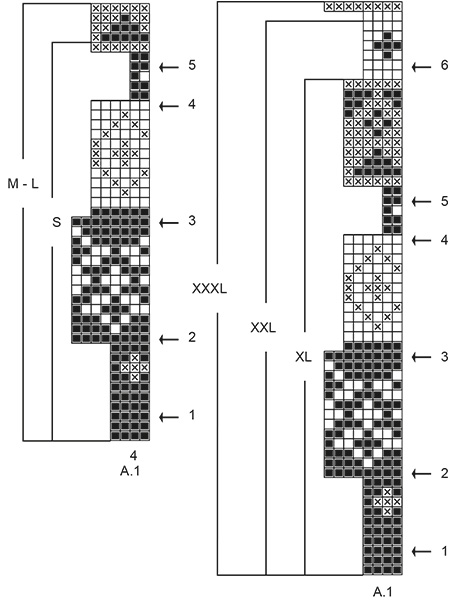
|
|||||||||||||||||||
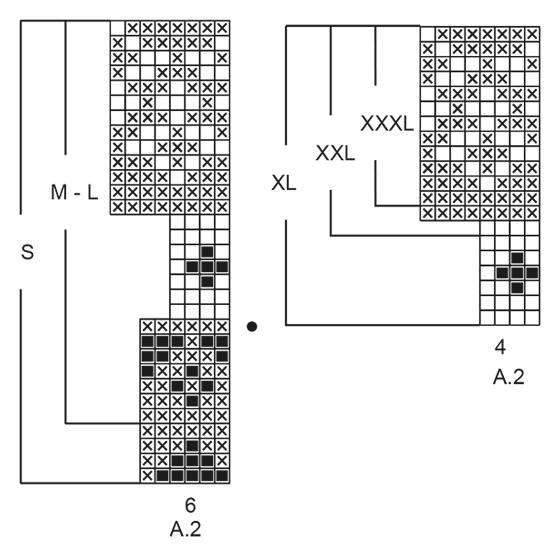
|
|||||||||||||||||||
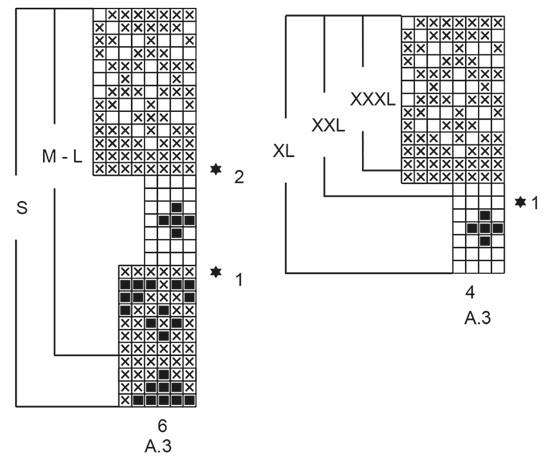
|
|||||||||||||||||||

|
|||||||||||||||||||
|
Have you made this or any other of our designs? Tag your pictures in social media with #dropsdesign so we can see them! Do you need help with this pattern?You'll find tutorial videos, a Comments/Questions area and more by visiting the pattern on garnstudio.com. © 1982-2024 DROPS Design A/S. We reserve all rights. This document, including all its sub-sections, has copyrights. Read more about what you can do with our patterns at the bottom of each pattern on our site. |
|||||||||||||||||||










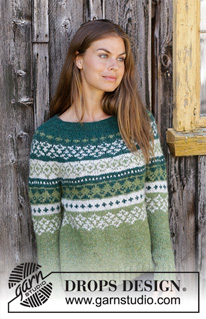















































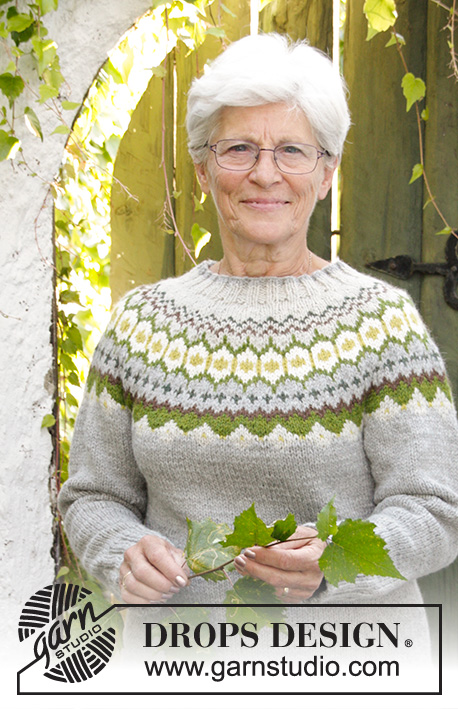






Comments / Questions (46)
I am confused about when to mark out the sleeves. I am doing the large size, and I am reading the pattern to start the sleeves after the A.2 chart is completed in height. But looking at the photos, that's the end of colour work. Help please? Thanks!
21.01.2024 - 19:15DROPS Design answered:
Dear Heather, you divide yoke on last round in A.1 then work A.2 on body but work A.3 on sleeves. Then after diagrams have been worked, just continue in stocking stitch. Happy knitting!
22.01.2024 - 10:27Hallo,ich habe Probleme,die Anleitung zu drucken,die Diagramme werden nicht gedruckt,ich kann die Anleitung auch nicht in meinen Datein speichern
28.12.2023 - 17:50DROPS Design answered:
Liebe Frau Maglung, beachten Sie, daß alle Seiten gedruckt werden; und auch daß Sie nicht schon zuviele Favorite haben. Viel Spaß beim stricken!
02.01.2024 - 09:41Hi Have started knitting the Bardu sweater pattern. I’m confused as to how to align the pattern when are increasing stitches in the yoke - means can either align the design horizontally or vertically. If vertically would mean that there will be gaps in the pattern horizontally where stitches were increased. If horizontally the crosses will not sit in same place above the diamonds, for example. I guess must seek to align it horizontally, except when get to lining up A2 above A1 (?) Thank you
09.09.2022 - 09:59DROPS Design answered:
Dear Fiona, when working the diagrams, the different stripes won't be lined up as in diagram because of the increases worked evenly, but you have enough stitches to repeat the new stripe over the new number of sts. Happy knitting!
09.09.2022 - 15:33Heisann! Jeg strikker Bardu genseren i størrelse M og er nesten ferdig med bolen, men målene på genseren min stemmer ikke overens med størrelsesdiagrammet. Målet over bolen skal ifølge diagrammet være på 47 cm, men hos meg er den 36. Jeg mener at jeg har fulgt oppskriften til punkt og prikke, kan dette være en feil i oppskriften, eller har jeg gjort noe galt på veien? Dette er første gang jeg strikker en genser.
18.04.2022 - 21:32DROPS Design answered:
Hei Karoline. Hvordan er strikkefastheten din? Når du strikker skal du få at 16 masker i bredden = 10 cm. Når man strikker mønster er det fort å strikke for stramt og noen ganger kan det hjelpe å strikke med en pinne større. Husk at den oppgitte pinne str. er kun veilledene. Får du for mange masker på 10 cm, bytt til tykkere pinner. Får du for få masker på 10 cm, bytt til tynnere pinner. mvh DROPS Design
19.04.2022 - 13:58I am choosing my next project from your wonderful selection. I would like to make a traditional yolk sweater in yarn group C and I have found three possibles. The yarn requirements for Lillehammer and Gemstone are about 17/18 balls whereas for Bardu I am getting 6 balls. Such a discrepancy does not seen likely . Thank you.
15.03.2022 - 11:33DROPS Design answered:
Dear Judy, Lillehammer is worked with DROPS Nepal / 50 g = approx. 75 m; while this jumper is worked with DROPS Air which is approx. 150 m (= double in length), reason why the total number of balls required is different for these 2 jumpers. Happy knitting!
15.03.2022 - 13:4550 g skovgrøn er ikke helt nok i str S, så måtte desværre købe 1 ekstra nøgle.
11.03.2022 - 18:53Hvordan forandrer jeg oppskrift fra S til XS
10.02.2022 - 14:00DROPS Design answered:
Hej Cecile, brystmålet på den mindste er 86 cm. Vi kan ikke hjælpe med at skrive opskriften om, men hvis du strikker den med en tyndere pind og får 17 masker på 10 cm (i stedet for de 16 m på 10 cm vi skriver i opskriften), så vil den blive lidt mindre...
11.02.2022 - 08:04Hi Garnstudio, Is the amount of materials correct? I was looking at 2 different designs with the same yarn group-group C. This one needs 300g for size M for a jumper. While the blue pine shore needs 350g for size M and it’s a sleeveless top. I’m a beginner so I just wanted to make sure that I’ll get enough yarns. Thank you
30.12.2021 - 11:36DROPS Design answered:
Hi Lieu, it is correct, DROPS Air is much more lighter and longer than DROPS Paris. Air -weight/length: 50 g = approx 150 m, Paris - weight/length: 50 g = approx 75 m. Happy knitting!
30.12.2021 - 13:48Liebes Drops Team, ich stricke das Model Bardu in M und habe eine Frage zum Rumpfteil. Ich habe 34 M gestrickt (passend A2 über A1 = 6M). 34 ist nicht durch 6 teilbar, wenn ich nach den 6 aufgenommenen Ärmelmaschen im Vorderteil weiterstricke verschiebt sich das Muster. Jetzt frage ich mich, wie ich weiterstricke, zumal ich das gesamte A2 Diagramm noch vor mir habe.
11.12.2021 - 13:48DROPS Design answered:
Liebe Yvette, stricken Sie weiter mit A.2 wie zuvor, aber sollte das Muster nicht in Runden passen, dann stricken Sie das Muster soviel möglich ist bis unter den Ärmel, damit A.2 in der Höhe wie zuvor gestrickt wird (wird nur nicht auf jeder Seite dann anpassen). Viel Spaß beim stricken!
13.12.2021 - 09:08Ho comprato da voi la kana x realizzare questo modello ma vorrei utilizzare ferri 3.5 come posso ricalcolare la quantità di maglie da mettere?
02.05.2021 - 12:05DROPS Design answered:
Buonasera Elvira, per questo modello deve utilizzare il numero di ferri che le consente di ottenere il campione indicato. Buon lavoro!
02.05.2021 - 20:04